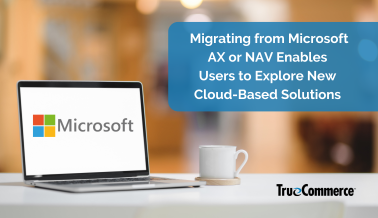Migrating from Microsoft AX or NAV Enables Users to Explore New Cloud-Based Solutions

February 1, 2023
If you are a Microsoft user, you may have heard Microsoft recently made a few important product support announcements pertaining to Microsoft Dynamics AX and NAV. As of January 10, 2023, all versions of Microsoft Dynamics AX have moved out of Mainstream Support. Additionally, Dynamics NAV 2013 and 2013 R2 have also reached the end of Extended Support, meaning they will receive no ongoing Microsoft support.
With the end of Mainstream Support from Microsoft, the AX and NAV platforms will no longer receive non-security updates, such as new features or design changes. Users will have access to Paid Support but will not have access to no-charge incident support. As a result, many users are looking to switch from Microsoft Dynamics AX or NAV to newer ERP systems. Regardless of if you are upgrading to another Microsoft system or moving to a new ERP provider, changing your ERP presents a unique opportunity to consider what other supply chain technologies you could enhance.
For example, a cloud-based EDI solution from a fully managed service provider like TrueCommerce may offer significant benefits when compared to your current system. These benefits can range from lower costs, to greater scalability, to increased visibility and efficiency.
How to Tell if It’s Time for a New EDI Solution
There are many reasons why you may want to consider migrating to a new provider that offers cloud-based, fully managed EDI. In fact, we’ve already identified seven key signs that it’s time to upgrade your solution on our blog. Among those primary reasons is that “you’re upgrading your ERP system.”
If you are using a non-integrated or legacy EDI system connected to Microsoft Dynamics AX or NAV, moving to a new ERP may require a complete overhaul of your EDI solution. Not only could you need to re-deploy your system with a new implementation for your new ERP, but you’ll also likely end up spending precious time updating every EDI document map for each of your trading partners.
Switching to a new EDI solution will also require some additional work. Still, if you choose a provider that offers plug-and-play EDI solutions that grow with you, you’ll be able to protect your business against wasted time for all future upgrades.
What if you don’t already have a cloud-based integrated EDI solution? To maintain a competitive edge, moving to the cloud and utilising an end-to-end solution that integrates with your ERP is key. Take, for instance, Conchita Foods. After implementing an EDI system that seamlessly integrated with their Microsoft Dynamics 365 Business Central environment, the company can easily handle seasonal order spikes. Using TrueCommerce, a single person can now process large order volumes with just a few clicks. While automation enables Conchita to manage EDI by exception, the web-based architecture lets their VP “have dinner with [his] family and take care of EDI in five minutes after [his] kids go to bed.”
Even if EDI wasn’t on your to-do list previously, many large and well-known retailers require the use of EDI. So, including an integrated EDI solution with your ERP now will ensure you are better prepared for future partnerships.
Taking Advantage of Cloud-Based EDI for Your ERP
While most EDI solutions enable you to standardise trading partner communications, not all providers offer software and service features that can help you grow. On-premises solutions lack real-time connectivity and may require large amounts of hands-on maintenance. Proprietary solutions can burden your team with compliance and security updates. Vendor portals may seem easier to manage but can become a headache as you expand your partnerships.
A growing number of companies are opting to migrate their EDI systems to the cloud. What’s more, these leading brands are choosing providers that offer a balance between cloud-based, self-service platforms and reliable managed service functions. This combination provides additional advantages like:
1. Cloud Accessibility, enabling management from practically anywhere with a wi-fi signal.
2. Flexibility and Scalability that meet demand needs without excess server costs.
3. Ensured Compliance with trading partner requirements thanks to frequent provider updates.
4. Low Maintenance Requirements that take the strain off your IT team.
Leading textile manufacturer, Frette, experienced these cost- and time-saving benefits when they implemented a cloud-based EDI integration for Microsoft Dynamics 365. Thanks to the modular framework provided by TrueCommerce, the brand was able to streamline everyday processes to reduce its total cost of ownership and operate at peak performance year-round.
Why Upgrade Your ERP and EDI at the Same Time
Upgrading your ERP system offers numerous opportunities to improve the efficiency of your supply chain. However, doing so without integrating your new ERP with your suppliers, sales channels, and partners could end up hindering your business growth. In order to enjoy the full benefits of your new ERP system, you need to be able to get data to and from the ERP quickly and accurately.
You might think that completing both an ERP upgrade and an EDI implementation at the same time would be overwhelming or take twice the time (and that might be the case if you were implementing a home-grown solution or using a provider who left all the work to you), but with a cloud-based, fully managed service EDI provider, you could actually end up saving time.
A flexible, supportive partner like TrueCommerce can give you the self-service tools you need to move your implementation forward while providing step-by-step support wherever you need it. Your provider should also have existing integrations with your new ERP and pre-mapped trading partner maps, which can expedite implementation. Plus, choosing an EDI solution in the cloud will mean there’s no need to endure expensive, time-consuming, and (let’s face it) frustrating server installations.
By choosing to upgrade their ERP and add in EDI simultaneously, luxury grocer Fortnum & Mason was able to do just that. What’s more, the combination of ERP and EDI enabled the brand to “improve the performance, reliability, and traceability of the integration into [their] third-party logistics provider.”
Get the Most Out of Your New ERP with TrueCommerce
As you move towards implementing a different ERP system, take time to consider if new, cloud-based solutions could make your supply chain even more efficient. If you’re already looking at solutions like EDI, remember that not all providers are equal. TrueCommerce offers a suite of cloud-based solutions that integrate with leading cloud ERP systems. In addition, our fully managed service approach can provide support from implementation to your day to day. With all the EDI transactions you need to stay compliant with your trading partners, top-of-the-line software security, and automated updates, we can help make a big change a lot less stressful.
To ensure you’re choosing the right vendor, you can use our EDI Buyer’s Guide, which includes a provider evaluation checklist. You can also reach out to one of our in-house supply chain experts for more information, or to get started.
Share this post:
Categories
Stay ahead of the competition
Get expert supply chain insights delivered directly to your inbox weekly.
